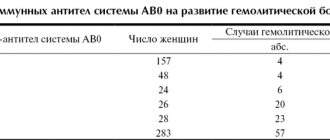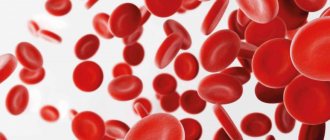Decoding the results is the competence of a pediatrician, therapist or specialist, since it is important not only to analyze the numbers, but also to compare deviations from the norms of different indicators, to compare the information obtained during examination and history taking. To have an overview and be prepared when you see your doctor, learn what blood elements are tested in the laboratory, how to interpret the results, and what abnormalities may mean.
Indications for analysis
MCV blood test is not the only one. To clarify the diagnosis, the therapist may require a retake or refer it for additional tests.
MCV is informative in two cases:
- in order to diagnose one of the types of anemia;
- to determine the type of water-salt imbalance. People are often sent for such an analysis if they have various intestinal infections, acute respiratory diseases and ARVI.
Other, no less serious, reasons for getting tested may be:
- failure of the hormonal system;
- metabolic problems;
- overweight;
- increased blood sugar or diabetes;
- a sharp and causeless decrease in the level of the immune system.
MCV analysis results often help identify such deviations:
- anemia of normochromic type. It is fixed when pathologies appear in the bone marrow, sometimes caused by chronic diseases;
- macrocytic type anemia. It is characterized by an excessive increase in mcv. Red blood cells increase in size due to insufficient amounts of vitamin B and folic acid;
- microcytic anemia. In this case, the disease occurs due to a lack of iron in the blood.
Red blood cells and their function in the body
Erythrocytes are red blood cells containing hemoglobin. Their main function is the transport of oxygen and carbon monoxide between the lungs and the tissues of other organs. In addition, red blood cells participate in the reactions of the immune system, play a significant role in maintaining the acid-base balance, and serve as a means of transport of nutrients (glucose, amino acids, salts, fatty acids) and breakdown products (uric acid, urea, ammonia, creatine).
Red blood cells are produced in the bone marrow. Their life cycle is 120 days, after which the red blood cells are metabolized by the cells of the liver, spleen and bone marrow. They are replaced by young forms of red blood cells called reticulocytes. Before entering the microvasculature, cells go through several stages of development, during which their shape, size and chemical composition change. For normal synthesis of red blood cells, a sufficient supply of vitamin B12, iron and folic acid is necessary.
Mature erythrocytes are anucleate cells that have the shape of biconcave discs, which allows them to penetrate into the narrowest and curved areas of the vascular bed. Due to the plasticity of red blood cells, the viscosity of blood in small capillaries is much less than in large ones.
The average diameter of a red blood cell in an adult is between 6.8 and 7.5 microns. Red blood cells with a diameter of less than 6.8 microns are called microcytes, and a condition in which the size of peripheral blood red blood cells is significantly smaller than normal means the presence of microcytosis. The presence in the blood of abnormally large red blood cells (macrocytes) with a diameter of more than 8 microns allows us to suspect macrocytosis in the patient.
The determination of the erythrocyte index is performed as part of a general blood test, but can also be prescribed as a separate study.
The average volume of erythrocytes has diagnostic value in assessing micro- and macrocytosis; it is used in calculating the average content and concentration of hemoglobin in erythrocytes.
Normal MCV values
| Age, gender | Mean erythrocyte volume, MCV, fl | |
| Children | ||
| 1 day - 14 days | 88,0 — 140,0 | |
| 14 days - 4.3 weeks | 91,0 — 112,0 | |
| 4.3 weeks - 8.6 weeks | 84,0 — 106,0 | |
| 8.6 weeks - 4 months | 76,0 — 97,0 | |
| 4 months – 6 months | 68,0 — 85,0 | |
| 6 months – 9 months | 70,0 — 85,0 | |
| 9 months - 12 months | 71,0 — 84,0 | |
| 12 months - 5 years | 73,0 — 85,0 | |
| 5 years - 10 years | 75,0 — 87,0 | |
| 10 years - 12 years | 76,0 — 90,0 | |
| 12 years - 15 years | Women | 73,0 — 95,0 |
| Men | 77,0 — 94,0 | |
| 15 years - 18 years | Women | 78,0 — 98,0 |
| Men | 79,0 — 95,0 | |
| 18 years - 45 years | Women | 81,0 — 100,0 |
| Men | 80,0 — 99,0 | |
| 45 years - 65 years | Women | 81,0 — 101,0 |
| Men | 81,0 — 101,0 | |
| 65 years - 120 years | Women | 81,0 — 102,0 |
| Men | 83,0 — 103,0 | |
In children under 10 years of age, the index may fluctuate and be inaccurate; later it returns to normal (80-100 fl).
MCV is higher than normal
If the results are above normal, this indicates the development of macrocytic anemia. It can be directly related to diseases such as:
- drug intoxication;
- food poisoning;
- problems with the thyroid gland;
- lack of iodine or iron in the body;
- liver dysfunction;
- oncological process of red bone marrow;
- long-term alcoholism;
- disruption of the pancreas.
An increase in mcv can be caused by:
- long-term use of birth control pills that affect hormonal levels;
- addiction to cigarettes and tobacco products;
- prolonged contact with toxic substances (work in hazardous industries);
- taking medications that increase the level of mcv in the blood.
If left untreated, macrocytic anemia can lead to frequent fainting, poor health, and low hemoglobin levels in the blood. Particularly at risk are:
- people who eat poorly, lead a sedentary lifestyle and ignore exercise;
- patients with chronic liver failure;
- people with a genetic predisposition to the disease;
- men over fifty-five years of age who abuse alcohol.
Experts identify some signs by which one can understand that a person’s red blood cell volume is too high:
- unhealthy pale lips;
- abdominal pain for no particular reason, which appears very often;
- the presence of tachycardia (heartbeat too fast), even when the person is at rest;
- skin with a yellowish tint.
If you notice similar symptoms or detect an increased level of mcv in the blood, you must immediately consult a general practitioner for appropriate treatment.
Reasons for increasing MCV
An increase in MCV in the blood may indicate a lack of vitamin B12, a lack of folic acid, the development of hyperchromic or macrocytic anemia, myelodysplastic syndrome, pathologies of the liver, bone marrow, renal failure, myxedema, hypothyroidism. The average volume of red blood cells may be increased in case of methanol poisoning, alcohol abuse, smoking, or taking certain medications.
False overestimation of the mean erythrocyte volume can occur with hyperglycemia and diabetic ketoacidosis, cold agglutination of erythrocytes.
Deviations of the MCV index from the norm in one direction or another can serve as an indicator of different types of anemia
MCV below normal
Tests showing that the volume of red blood cells is below normal also indicates pathology. Experts name a number of reasons that can lead to such results:
- genetic predisposition;
- insufficient amount of water consumed;
- development of various types of anemia;
- lead intoxication;
- the presence of malignant formations, tumors in the body;
- taking medications that affect test results.
In medical circles, a disease in which the level of red blood cells in the body decreases is commonly called microcytic anemia. The peculiarity of the disease is that red blood cells do not perform their transport function, i.e. they do not deliver oxygen and other useful substances to the body’s cells in the required quantities.
With this pathology, a characteristic clinical picture is observed:
- constant fatigue;
- increased irritability, nervousness;
- decreased concentration and performance;
- absent-mindedness;
- memory impairment.
A decrease in the volume of red blood cells is always observed with various types of blood loss.
Pregnancy and mcv
During pregnancy, due to the body's increased consumption of iron, microcytic anemia can develop. This condition can negatively affect both the health of the unborn child and the well-being of the mother.
Some experts are convinced that mcv indicators are directly related to a person’s psychological state.
What does MCV show in a complete blood count?
Red blood cells, called erythrocytes, normally vary in number and shape. But at the same time, in a healthy body, most of them should be correct, accepted as a normal shape. This is directly related to the functional ability of red blood cells, that is, a healthy cell - a normocyte - fully participates in the transfer of oxygen to the tissue structures of the body. And after destruction, it will be replaced by an equally efficient red blood cell.
If the shape of the red blood cell is changed, and it is an ovalocyte, macrocyte, microcyte or schistocyte (fragmented cascade cell), certain difficulties with oxygen transport may be observed. This heterogeneity of red blood cells can cause other adverse effects. Therefore, in many situations, when making a diagnosis, data from not only a general blood test is used, but also a detailed one - allowing one to evaluate in detail the characteristics of each group of cells - red blood cells, leukocytes, platelets and their varieties.
MCV values are calculated by dividing the total blood cell volume by the total red blood cell count. The formation of cells of altered shape is called heterogeneity, and this condition leads to deviations from the generally accepted norm. If MCV in a blood test is low, these cells are called macrocytes, and if red blood cells are characterized by a decrease in volume, then they are called microcytes.
Normal red blood cell and types of pathologically altered cells
This indicator can be calculated in two quantities - cubic micrometers (µm3) and femtoliters (fl). When carrying out diagnostics in laboratory conditions, it is automatically measured by the analyzer. In a blood test, in addition to MCV - the average volume of red blood cells, several other values characterizing these blood cells are measured. This:
- RBC – information about the number of red blood cells;
- MCH (color indicator) - makes it possible to determine the average amount of hemoglobin contained in each individual red blood cell;
- MCHC - shows the average amount of hemoglobin contained in all red blood cells of the human body;
- RDW-CV – provides information on the width of the red blood cell distribution;
- Hematocrit (HCT or Ht) is the percentage ratio of the volume of red blood cells to the rest of the blood cells.
In some cases, if there are symptoms of joint damage or aggravated rheumatoid heredity, it is recommended to take a blood test for anti-MCV. This study is not particularly relevant to the study of qualitative and quantitative characteristics of red blood cells. It is carried out to detect antibodies to citrullinated vimentin, a protein used to diagnose rheumatoid arthritis. An increase in anti-MCV levels in the blood is observed 10–15 years before the appearance of obvious symptoms of the disease.
Therefore, if the interpretation of the received blood test materials indicates that the anti-MCV level is elevated, the rheumatologist must definitely take this into account. First of all, the patient must be explained the importance of regular blood donation for a general and detailed analysis of its components, and this must include the anti-MCV indicator
Studying the latter value alone is not enough to understand the overall picture of the patient’s condition, and a comprehensive diagnosis will allow one to recognize the onset of the disease in time and take appropriate measures.
Features of the analysis
Today, the mcv test is included in the general blood test or can be performed separately from other indicators. To donate blood, the patient must come to the treatment room, where a laboratory technician or nurse will take blood samples from a finger or vein. Blood sampling is carried out in accordance with all sanitary and epidemiological regulations (SanPiN).
The patient is required to comply with the following rules:
- You need to donate blood on an empty stomach (5-12 hours after your last meal);
- at the time of donation, the woman should not be menstruating;
- feeling normal. It is prohibited to take blood samples if the patient is not feeling well, is in a coma or is in cardiac shock.
Normal indicators
Acceptable limits of values, defined as the MCV norm in a blood test, change throughout a person’s life. In addition, several factors may affect the examination materials, for example, a large breakfast, laboratory inaccuracies, drinking drinks containing alcohol, taking antidepressants or hormonal medications.
In children under one year of age, 71–112 fl are considered normal values, with newborns having the highest values for childhood. However, as a child grows and develops, the MCV level gradually decreases to levels accepted as normal in an adult. Then, as the body matures, the standard values increase again. It is noted that the MCV rate in women is slightly higher than in men.
MCV standards - children and adolescents







